
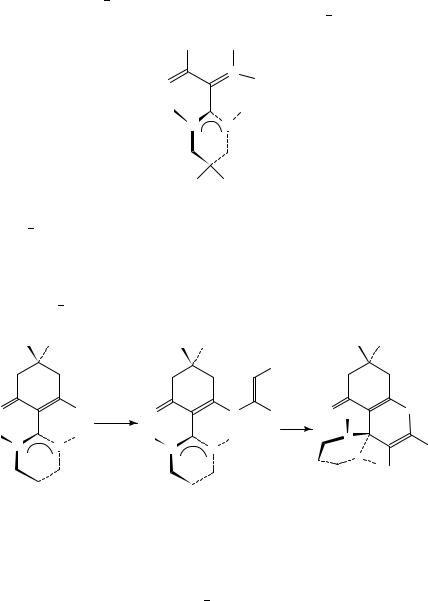
21. Strained olefins |
1263 |
destabilized by dipole dipole repulsion, could not be observed, but lineshape analysis revealed that it plays a role as high-energy intermediate in the EZ ZE exchange50.
Me O−
C
O |
Me |
Me Me
N + N
Me Me
(13)
Push pull ethylenes are unreactive toward normal double-bond reagents51. The dipolar character of the twisted representatives might have made them attractive substrates for addition reactions with dipolarophiles. However, reactions of a series of typical compounds, analogues of 6 and 7, with dimethyl acetylenedicarboxylate (DMAD) led to addition of the dipolarophile between a negatively charged oxygen or sulfur atom in the acceptor part and the positive carbon atom in the donor part (Scheme 3), leading to spiro compounds52 54. The reaction probably proceeds in steps, since in the presence of water the first adduct (A) is protonated, and the reaction takes a different route55.
|
|
|
|
|
|
|
− |
E |
|
|
|
|
|
|
|
|
|
|
|
|
|
X |
|
|
Y− |
DMA D X |
|
Y |
|
E |
X R |
Y |
|
|
|
|
|
||||||
R |
|
|
R |
R |
|
R |
|
|
N |
|
N |
|
N |
|
|
|
|
E |
|||
+ |
|
N |
+ |
N |
|
|
|
|||
|
|
|
|
|
|
N |
||||
|
|
|
|
|
|
|
|
|
||
|
|
|
|
|
|
|
|
|
|
R E |
E = CO2 Me |
|
|
|
A |
|
|
|
|
|
|
X, Y = O, S |
|
|
|
|
|
|
|
|
|
|
SCHEME 3
The ultraviolet absorption spectra of a number of untwisted and twisted compounds of the types 5, 6 and 7 have been studied43,45 and found to be compatible with the chromophore in the acceptor part. The same was found for the photoelectron spectra of a series of more or less twisted simple push pull ethylenes56.
IV. BIS-TRICYCLIC ETHYLENES
These compounds have long been of interest, among other things because of their generally strong color and the thermochromic, piezochromic and photochromic properties of some of them. Two main types can be recognized, the bifluorenylidenes 14 with
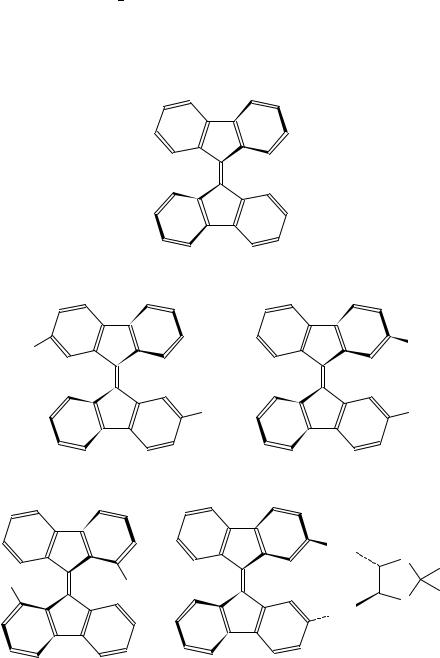
1264 |
Jan Sandstrom¨ |
five-membered central rings, and the bianthronylidenes, dixanthylenes, biacrylidenes and the bianthrylidenes 15a 15d with six-membered central rings. Compounds with sevenmembered central rings (15) have also been described.
Coplanarity is made impossible by the close approach of the neighboring peri hydrogen atoms (H-1, H-10 and H-8, H-80/H-9, H-90 ), and these compounds have two principal routes to minimize the steric strain based on the mechanisms mentioned in Section I. One way, twisting, is to rotate the two halves of the molecule about the formal double bond
(14a)
H2 N |
|
|
NH2 |
|
|
|
|
||
|
NH2 |
|
NH2 |
|
|
E |
|
Z |
|
|
(14b) |
|
|
|
|
|
|
CO2 CH2 |
|
|
|
|
O |
|
R |
|
M |
S |
|
R |
S |
|||
|
|
|||
|
|
|
||
|
|
|
O |
|
|
|
|
CO2 CH2 |
(14c) R = CO2 Pr-i |
(14d) |
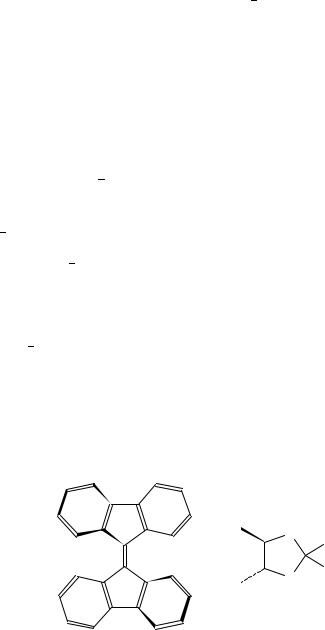
21. Strained olefins |
1265 |
while retaining the planarity of the tricyclic parts, and another, folding, is to introduce pyramidalization at the double-bond carbon atoms, leading to anti- or syn-folding of the tricyclic parts (Scheme 4). A combination of the two routes is also feasible.
The symmetry properties of the parent compounds 14 16 and their substituted derivatives plays a great role in the analysis of their chirality and dynamic behavior. These properties have been analyzed in detail by Agranat and coworkers57.
Due to complications in the crystal structure, the X-ray crystallographic analysis of the parent bifluorenylidene (14a) for a long time gave conflicting results. However, it is now generally accepted58,59 that 14a has a twisted structure. The value of the twist angle depends on how it is measured. The mean angle between the mean planes of the fluorene parts is 42.3°, whereas the mean of the dihedral angles at the 9,90 bond is 32.8°. The difference is due to a slight deformation of the nearly planar fluorene parts. Molecular force-field60 and MNDO-PM357 calculations have given similar results, with twist angles of 42.9° and 30.2°, respectively. Substitution in the 1,10 ,8,80 positions increases the twist angle, up to 67° in the perchloro derivative61.
The twist-angle dependence of the energy of the molecule can be expected to be similar to that of the case 3 push pull systems discussed above (Figure 3) with energy maxima at ca 0°, 90°, 190° and 270°. Derivatives, which are unsymmetrically substituted in the individual fluorene units (e.g. 1,10- or 2,20-substituted) can exist as enantiomeric pairs of E and Z forms (Figure 4). Racemization occurs by passage through the planar state and E Z exchange by passage through the perpendicular state. The E and Z forms of 2,20 -diamino-bifluorenylidene (14b) were resolved by chromatography already in 1953,
and the barrier to E Z exchange was found to be 25 kcal mol 162 .
Early determinations of the barriers for the two kinds of processes employing the temperature dependence of the NMR spectra were made with 1,10 -substituted derivatives with substituents containing prochiral groups, e.g. 14c63. The two kinds of barriers were found to be very similar, ca 20 kcal mol 1. However, it is evident that the 1,10 -substituents increase the racemization barrier by increasing the strain in the planar state and lower the barrier to E Z exchange by increasing the ground-state strain.
Luh and coworkers have developed a new desulfur-dimerization of thioketals by treatment with tungsten hexacarbonyl to form CDC bonds64,65. Application of this reaction to the diester of 9,9-ethylenedithiofluorene-2-carboxylic acid and (R,R)- or (S,S)-2,2- dimethyl-4,5-bis(hydroxymethyl)-1,3-dioxolane led to enantiomeric bifluorenylidenes of unknown optical purity with the 2,20 positions connected by a chiral bridge (14d, 14e)66. These compounds display high specific rotations, [˛]22D D C634° and 690° for the enantiomers with S and R configuration of the bifluorenylidene moiety, respectively. They are optically stable, which is ascribed to the rigidity imposed by the dioxolane ring. When the
 CO2 CH2
CO2 CH2
O
R
P R
O
 CO2 CH2
CO2 CH2
(14e)
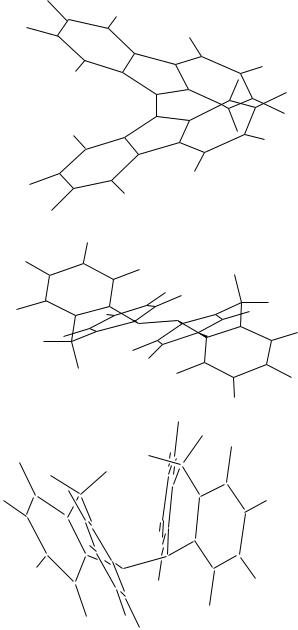
1266 |
Jan Sandstrom¨ |
Twisted bifluorenylidene
Anti-folded bianthrylidene
Syn-folded bianthrylidene
SCHEME 4

21. Strained olefins |
1267 |
R
R
tM-Z
FIGURE 4. dene
+ |
|
|
|
|
|
|
|
|
|
|
|
∆H+ (kcal mol−1) |
|
|
|
|
|
|
|
|
|
||
30 |
|
|
|
|
|
|
|
|
|
|
|
|
|
|
t P |
|
|
t M |
|
|
|
|
|
20 |
|
|
|
|
|
|
|
|
|
|
|
10 |
SZ |
|
|
|
SE |
|
|
|
|
|
|
|
aZ |
|
|
|
aE |
|
|
|
|
|
|
tM−Z |
0 |
tP−Z |
90 |
tM−E 180 |
tP−E |
270 |
tP−Z |
|
|
|
|
|
R |
|
|
|
|
|
R |
R |
|
|
|
|
|
|
|
|
|
|
|
|
|
|
|
|
R |
|
|
|
|
|
|
SP-E |
|
|
|
|
aP-Z |
|
|
|
|
|
|
|
|
|
|
|
|
|
|
R |
R |
R |
|
R |
|
|
|
|
|
|
|
|
|
|
|
|
|||
|
|
|
|
|
|
|
|
|
|
|
|
|
R |
|
|
|
|
|
|
|
|
|
|
|
R |
|
|
|
|
|
R |
|
R |
|
|
|
SZ |
|
|
R |
|
tM-E |
|
aE |
|
R |
|
|
|
t |
|
|
t |
P-E |
|||||
|
|
|
P-Z |
|
|
|
|
|
|
||
|
|
|
|
|
|
|
|
|
|
|
|
|
R |
|
|
|
|
|
|
|
|
|
|
|
R |
|
|
|
|
|
R |
R |
|
|
|
|
|
|
|
|
|
|
|
|
|
||
aM-Z |
|
|
|
|
|
|
S |
|
|
|
|
|
|
|
|
|
|
|
|
M-E |
|
|
|
Schematic potential energy curve and exchange pathways for a 2,20 -substituted bifluorenyli-
ring is replaced by two methoxy groups (14f), a labile system with low specific rotation is formed, evidently a nearly 1:1 mixture of two rapidly interconverting diasteromers with opposite chiralities of the bifluorenylidene units. The 1H NMR spectrum shows only one set of signals at ambient temperature, but it splits into two sets below 20 °C, corresponding to a barrier to racemization of 12 kcal mol 1. The exchange process is suggested to proceed with pyramidalization at one or both of C-9 and C-90 .
In a following study, Luh and coworkers67 describe the preparation of the E and Z isomers of 14g in the ratio 85:15 by reaction of 14h with (R)-1-phenylethylamine in refluxing dichloromethane. The Z isomer of 14g is shown to rearrange rapidly to E in boiling ethanol, although no rate or barrier data are reported. The Z isomer of 14g also shows an equilibrium between (P,R,R) and (M,R,R) forms (epimerization) with a barrier of 11.5 kcal mol 1. A number of 2,20-di- and polyetherand -diester-bridged analogues are described, and the hydrolysis of one of the latter gave the pure Z form of 14h, not isomerized to the E form even at C160 °C.
Grieser and Hafner68 report the preparation of a 1:1 mixture of the E and Z isomers of bi(cyclohepta[def]fluorenylidene), 14i and 14k. A racemization barrier of 15.0 kcal mol 1
1268 |
Jan Sandstrom¨ |
CO2 CH3
OMe
OMe
 CO2 CH3
CO2 CH3
(14f)
CONH |
Ph |
|
H |
M |
C R |
|
Me |
CONH |
Ph |
|
H |
|
C R |
(14g) |
Me |
|
 R
R
R
(14h) |
R = CO2 H |
(14i) M-E |
(14k) P-Z |
(14l) |
R = Me |
|
|
(14m) |
R = Pr-i |
|
|
was determined by NMR lineshape analysis. The reason for this comparatively high barrier may be the rigidity imposed by the 4,5 and 40,50 bridges.
In a recent work, Agranat and coworkers69 report studies of the temperature-dependent 1H and 13C NMR spectra of 2,20 -dimethyl- (14l) and 2,20-diisopropylbifluorenylidene (14m). The free-energy barrier to racemization in 14m was determined as being
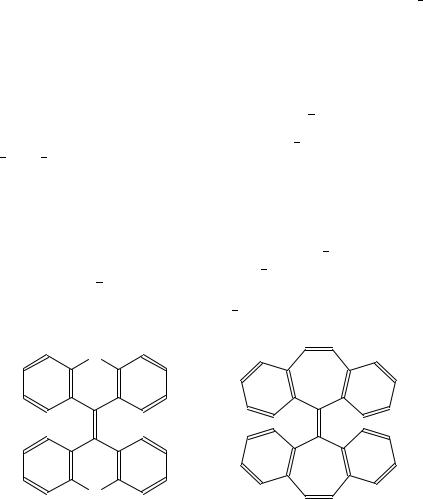
21. Strained olefins |
1269 |
11.5 kcal mol 1, in good agreement with the value for 14g. A similar study of the E Z exchange in 14l gave a barrier of 25 kcal mol 1, fixing the value of this barrier in an unrestrained bifluorenylidene.
Based on PM3 calculations on 14a, Agranat and coworkers69 have proposed a detailed mechanism for the dynamic processes in 14l and 14m (Figure 4). The racemization is predicted to proceed via an anti- folded intermediate a, which is calculated to be 4.6 kcal mol 1 above the ground state t; a and t are separated by a transition state, the energy of which is not reported An alternative but less likely racemization route proceeds via a syn -folded transition state s, 8.2 kcal mol 1 above t. The E Z exchange is predicted to occur with a perpendicular transition state t? , 25.0 kcal mol 1 above t. The latter value is in very good agreement with the experimental barrier to E Z exchange. Passage from tM Z to tP Z via a planar transition state is very unlikely, since the energy of this state is calculated to be 29.4 kcal mol 1 above that of t. In the proposed itinerary, every transition state involves at most one edge passage.
X-ray crystallographic studies have shown that bistricyclic compounds with sixmembered central rings are anti-folded, e.g. bianthrone (15a)70,71 and dixanthylene (15b)72. The unsubstituted compounds are centrosymmetric, but symmetric tagging, e.g. by introducing equal 2- and 20-substituents, permits the existence of E and Z isomers, each of them a pair of enantiomers. Agranat and coworkers73 79 have used a 1H NMR bandshape technique to study the barriers to E Z exchange and to racemization in derivatives of 15a c, substituted in 2,20 position with methyl or isopropyl groups. The barriers to the two processes were found to be very similar, indicating a common transition state. The barriers were found to be 20 22 kcal mol 1 for 15a and 15c, and ca 18 kcal mol 1 for 15b.
X
|
X |
|
||
(15a) |
X = C |
|
O |
(16) |
|
||||
|
||||
(15b) |
X = O |
|
||
(15c) |
X = NMe |
|
||
(15d) |
X = CH2 |
|
||
Using the force-field method of Warshel and Karplus80, Korenstein, Moszkat and coworkers81,82 found three minimum energy conformations for dianthrylidenes. The one predicted to be most stable (A) was the anti-folded form found in the crystal70; the following one (B) was the twisted form with twist angles in the range 50° to 60°. The third, still higher in energy, is syn-folded (E). The calculations predict B to be 2 kcal mol 1 above A and E to be another 11 kcal mol 1 higher. MNDO-PM3 calculations on dixanthylene 15b57 predict an anti-folded A form very similar to that in the crystal to be the most stable
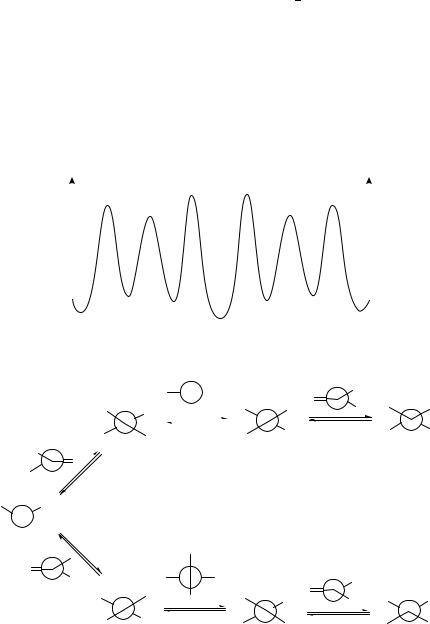
1270 |
Jan Sandstrom¨ |
one with the syn-folded E form 4.1 kcal mol 1 and the twisted B form with a 49° twist angle 8.7 kcal mol 1 above the ground state. Evidently, forms B and E may be considered as intermediates on the itineraries between the E and Z and between the P and M forms.
The energy curve proposed by Agranat and coworkers75 78 for the interconversions (Figure 5) is similar to that in Figure 4, with the difference that the anti-folded forms now are the ground states and the twisted forms are higher-energy intermediates. The interconversions are based on the principle of only allowing one edge passage at a time and not to allow substituted edges to pass one another. The syn-folded form E is not considered, and it is not expected to facilitate the interconversions even if it represents an energy minimum on the total energy hypersurface.
In bianthrones (15a) the B form is thermally and photochemically83 accessible, and both the B ! A barrier ( H‡) and H° could be determined by monitoring the equilibrium and the reaction rate as functions of the temperature79. The B ! A barrier was found to
∆E (kcal mol−1)
20 |
|
|
|
|
|
|
|
|
|
|
|
|
|
|
|
|
|
|
|
|
|
|
|
|
|
|
|
|
|
|
|
|
|
|
|
|
|
|
|
|
|
10 |
|
|
|
|
t |
M−Z |
tP−E |
|
|
|
t |
M−E |
tP−Z |
|
||||||
|
|
|
|
|
|
|
|
|||||||||||||
|
|
|
|
|
|
|
|
|
||||||||||||
|
|
|
|
|
|
|
|
|
|
|
|
|
||||||||
|
|
|
|
|
|
|
|
|
|
|
|
|
|
|
|
|
||||
|
|
|
|
|
|
|
|
|
|
|
|
|
|
|
||||||
0 |
|
|
90 |
180 |
|
270 |
360 |
|
||||||||||||
aM−Z |
|
|
|
|
|
|
|
aE |
|
|
|
aP−Z |
|
|||||||
|
|
|
|
|
|
|
|
R |
|
|
|
|
|
|
||||||
|
|
|
|
|
|
|
|
|
|
|
R |
|
|
|
R |
|
||||
|
|
|
|
R |
|
R |
|
|
|
|
R |
R |
R |
|||||||
|
|
|
|
|
|
|
|
|
|
|
|
|
||||||||
|
|
|
|
|
|
|
|
|
|
|
|
|
|
R |
|
|
R |
|||
|
|
|
|
|
|
|
|
|
|
|
|
|
|
|
|
|
|
|||
|
|
|
|
|
|
|
|
|
|
|
|
|
|
|
|
|
|
|||
|
|
|
|
|
|
|
|
|
|
|
|
|
|
|
|
|
|
|||
|
|
|
|
|
tM -E |
|
|
|
|
|
|
|
|
tP-Z |
|
|
aP-Z |
|||
R
R
R
R a E
a E
R
R |
|
R |
R |
|
|
|
|
|
|
|
R |
R |
R |
R |
R |
R |
R |
|
R |
tP-E |
|
|||
|
tM -Z |
|
aM -Z |
FIGURE 5. Schematic potential energy curve and exchange pathways for a 2,20 -substituted bianthrone
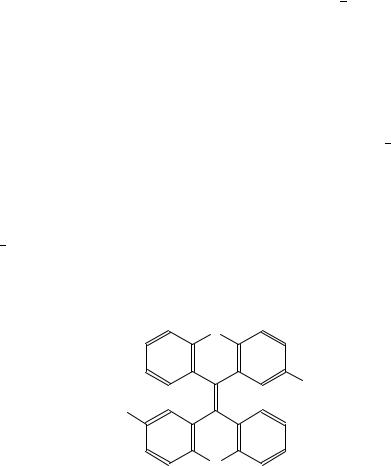
|
|
21. Strained olefins |
1271 |
be 16.1 |
š |
0.7 kcal mol 1 and the enthalpy difference 4.2 kcal mol 1, in good agreement |
|
|
78 |
|
|
with the experimental free-energy barrier of 21.5 š 0.3 kcal mol 1 . |
|
||
The changes in the bianthrones and bixanthylidenes can be followed photometrically, since the visible absorption occurs at much longer wavelength (600 650 nm) in the B form than in the A form ( 400 nm)83. The A ! B transition is favoured by high pressure on the crystal (triboluminescence) or in solution84.
To judge from the double bond lengths (138 pm in 14a58, 132 pm in 15a70) the anti-folded structure preserves the double bond character better than the twisted one. Semiempirical calculations (CNDO/S) show that the -overlap across the double bond is much more diminished by a twisting in 15a than by an anti-folding leading to the same increase in H-1 H-10 and H-9 H-90 separation. Folding in compounds 14 is unfavorable because of the restraint imposed by the Ar Ar bond.
Feringa and coworkers85 have resolved 2-methyl-9H-thioxanthene-9-(9H-thioxanthen- 9-ylidene) (17a) and some homoand heteromerous57 analogues (17b 17d) by chromatography with (C)-polytriphenylmethylmethacrylate86 as chiral stationary phase. Only the monothio-bixanthylidene 17e could not be resolved, presumably because the barrier is below 20 kcal mol 1. The 2,20 -dimethyl-bithioxanthylidene 17d was separated into three components, the centrosymetric E isomer and two enantiomers of the Z isomer. The racemization barriers for 17a and 17d were as high as 27.2 š 0.2 kcal mol 1, 9.4 kcal mol 1 higher than for the analogous dixanthylidene 17b76. The barrier for E Z exchange was also ca 27 kcal mol 1, supporting the mechanism discussed above (Figure 5). An interesting correlation was found between the barriers and the aryl-X bond lengths (Table 4), which can be related to the expansion of the central ring. Feringa and coworkers have also studied the thermal and photochemical isomerizations of analogues of 17a with a view to their use as molecular switches.87,88
S
R1
R2
X
(17a) X = S, R1 = Me, R2 = H
(17b) X = CMe2 , R1 = Me, R2 = H
(17c) X = NMe, R1 = Me, R2 = H
(17d) X = S, R1 = R2 = Me
(17e) X = O, R1 = Me, R2 = H
A bistricyclic ethylene with seven-membered central rings, 5,50 -bis-5H-dibenzo[a,d]cy- cloheptenylidene (16), has been found to give two stable steroisomers, one with syn- and the other with anti-folding89. An extreme case of syn-folding is represented by 9,90,10,100 - tetrahydrodianthracene (18)90, in which the anthracene rings in a bianthrylidene are bent backward to the extent of permitting double bonds between the 9,90 and 10,100 positions.

1272 |
|
Jan Sandstrom¨ |
|
|
||||
|
TABLE 4. |
Relation between C X |
bond lengths and racemization |
|||||
|
|
85 |
|
|
||||
|
barriers for compounds 17a |
|
17c and 17e |
|
|
|
||
|
|
|
|
|||||
|
Compound |
X |
|
rC X (pm) |
Grac‡ (kcal mol 1) |
|||
|
|
|
|
|
|
|
|
|
|
17a |
S |
177 |
|
27.4 |
š 0.2 |
||
|
17b |
CMe2 |
152 |
|
25.1 |
š 0.3 |
||
|
17c |
NMe |
142 |
|
21.3 |
š 0.5 |
||
|
17e |
O |
138 |
|
<20.0 |
|
||
|
|
|
|
|
|
|
|
N |
|
|
|
|
|
|
|
|
N |
|
|
|
|
|
|
|
|
Ph |
|
|
|
|
|
|
Ph |
|
|
|
|
|
|
|
|
|
N |
|
|
|
|
|
|
|
|
N |
|
|
|
(18) |
|
|
|
|
(19) |
|
According to Haddon9, this compound possesses the most strongly pyramidalized doublebond carbon atoms of all structurally characterized molecules see below (Table 6).
A bis-bicyclic compound, 19, has been studied by X-ray crystallography and was found to assume an anti-folded structure91.
V. MEDIUM-SIZED trans-CYCLOALKENES AND ANALOGUES
Cyclodecene is the smallest cycloalkene, which can accommodate a trans double bond without significant deformation of bond angles and/or dihedral angles. The strain energies and structures of smaller trans-cycloalkenes have been the subjects of considerable research over the years.
trans- or E-1-Phenylcyclohexene has only been observed as an extremely short-lived species on laser photolysis of the Z isomer92. Seven-membered analogues show much greater stability. E-Cycloheptene has been generated photochemically, and the enthalpy
barrier to isomerization to the Z isomer was measured to be 18.2š1.2 kcal mol 193 , whereas the corresponding barrier for E-1-phenylcycloheptene was found to be
20.9 kcal mol 194 . The strain energy of the E in excess of the Z form of unsubstituted cycloheptene has been calculated to be 20.3 kcal mol 1 with a C CDC C dihedral angle
of 125°, corresponding to an OS value of 19.6 kcal mol 195 .
The most-studied member of this group is trans- or E-cyclooctene (20a). The bridging of the trans-1,2-positions by a hexamethylene chain imposes too much strain to permit a planar double-bond system. Electron diffraction studies96 and EFF calculations95 97 show that the molecule has a crown or twist conformation with a C CDC C dihedral angle of 136°. The olefinic carbon atoms are slightly pyramidalized, and the situation at the double bond can be described as a combination of twisting and syn-folding. Studies of E-1-methyl-cyclooctene (20b) show the same kind of deformations, but a diminished C CDC C dihedral angle (130.3°) and increased pyramidality at C-1 but diminished at C-298.
